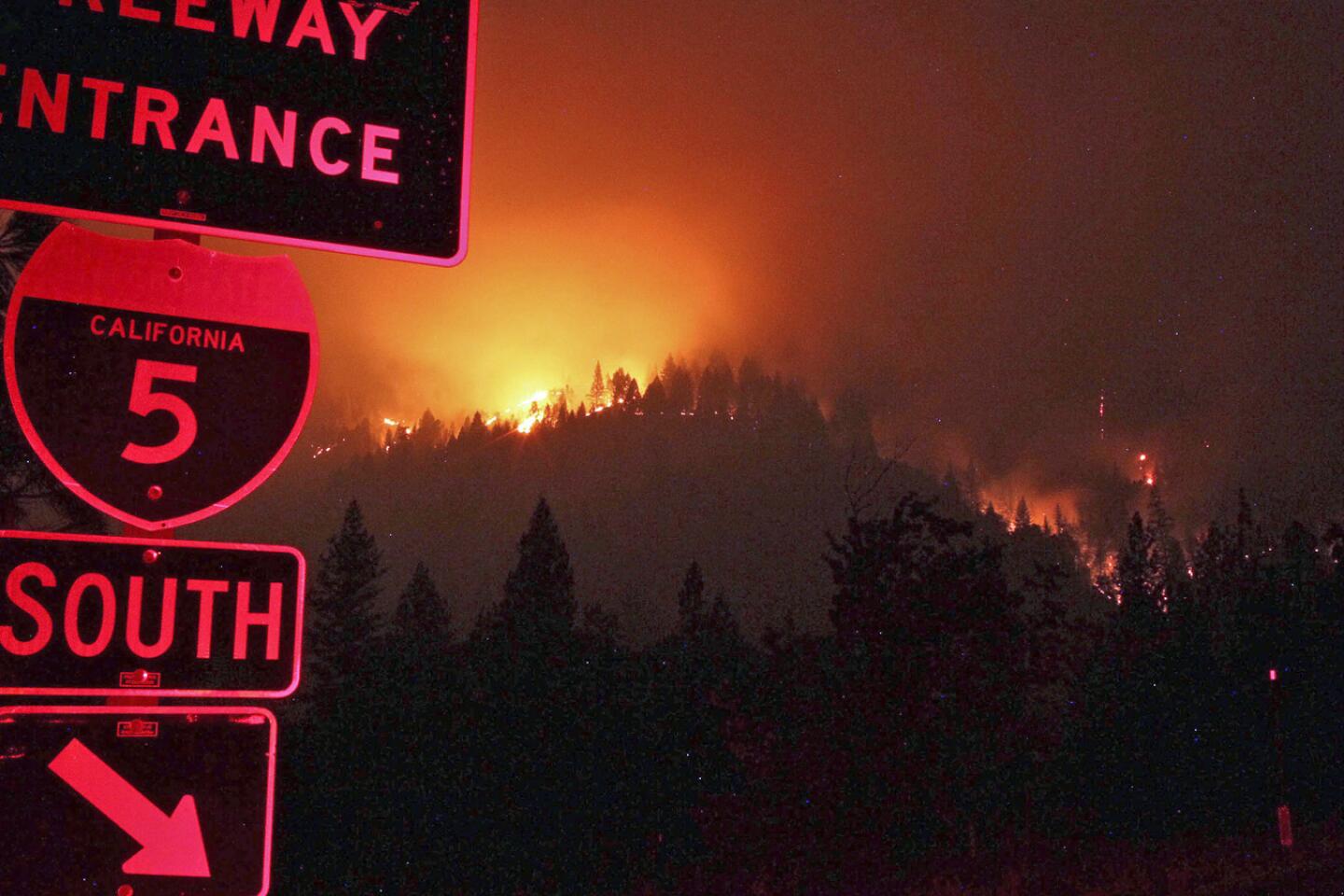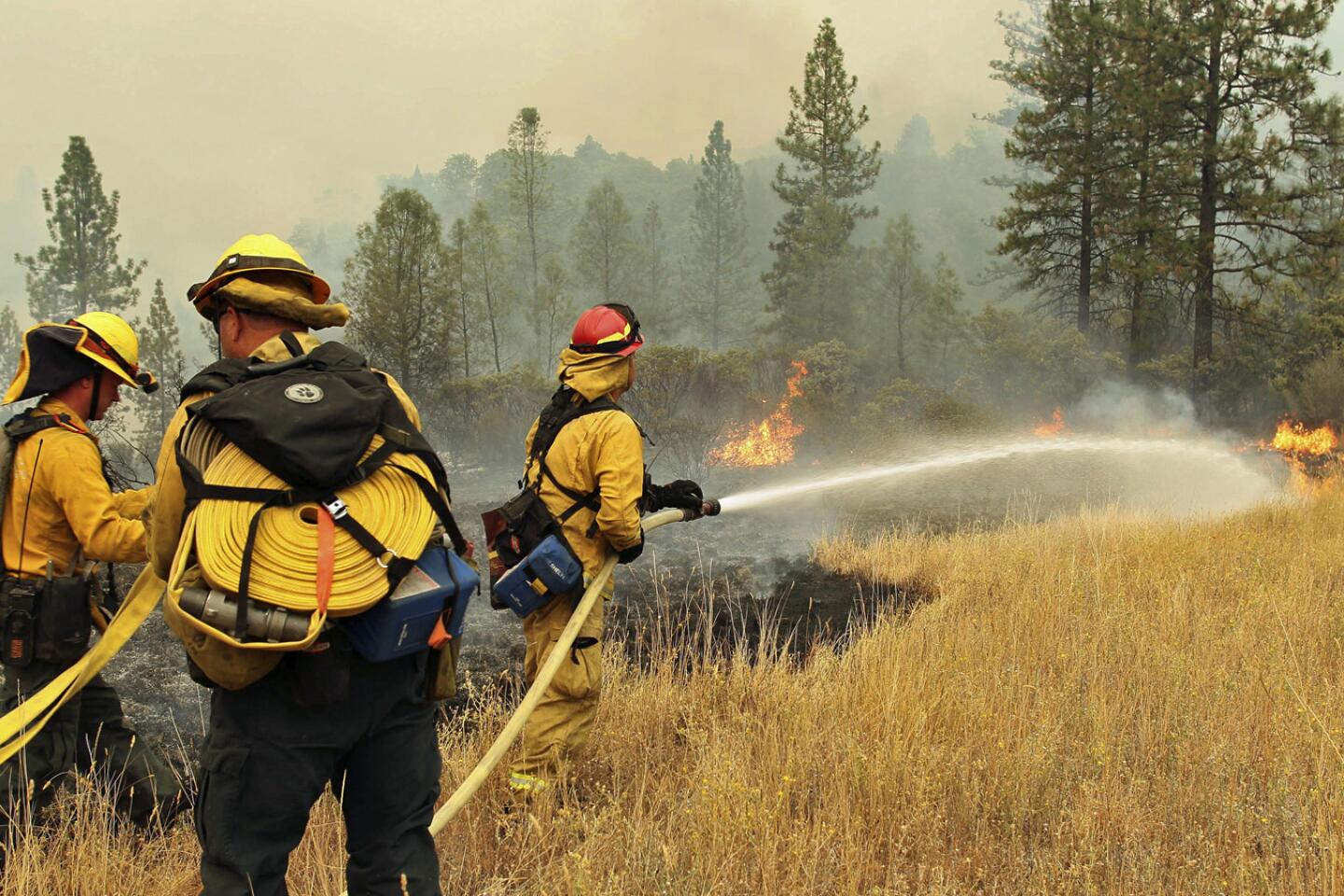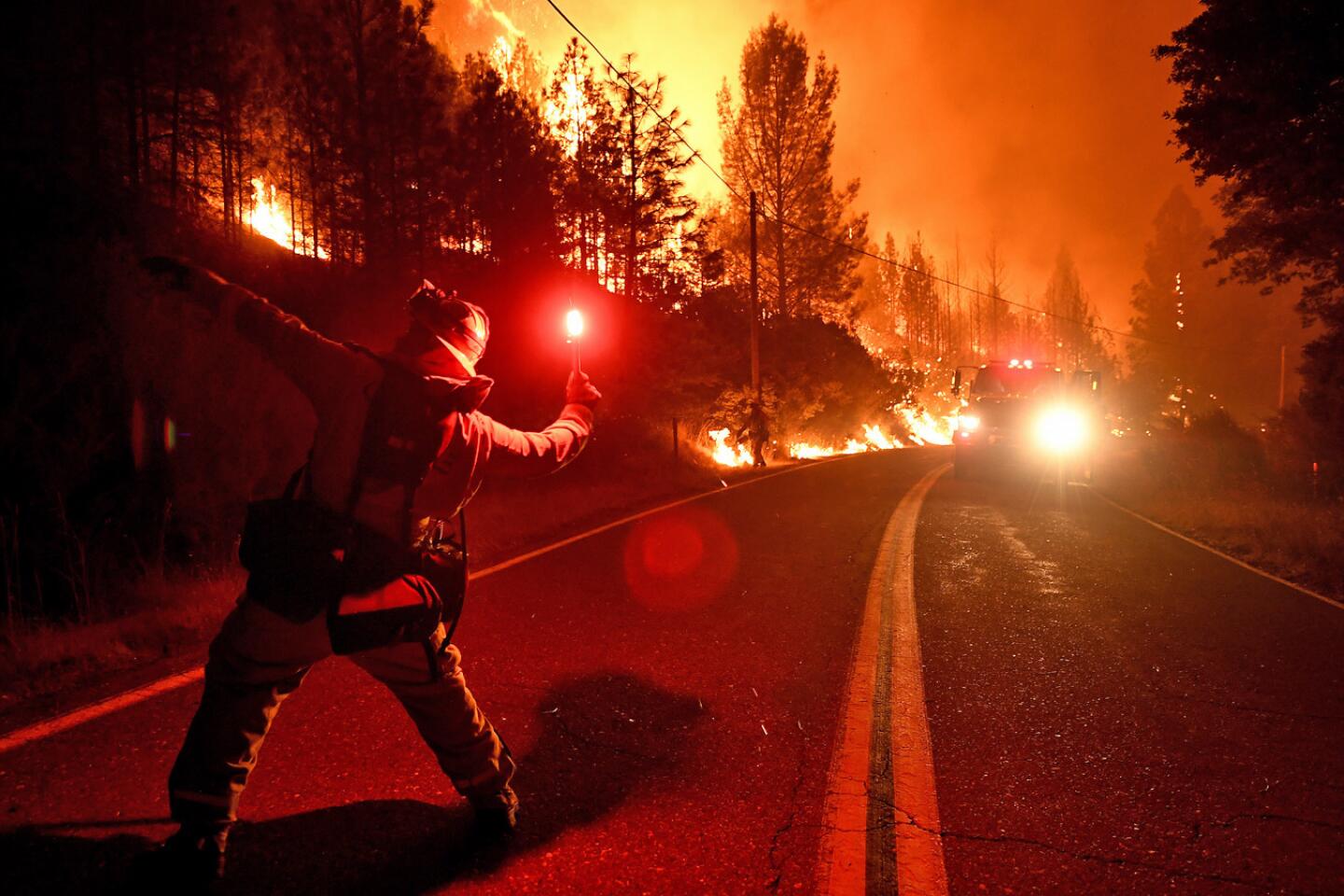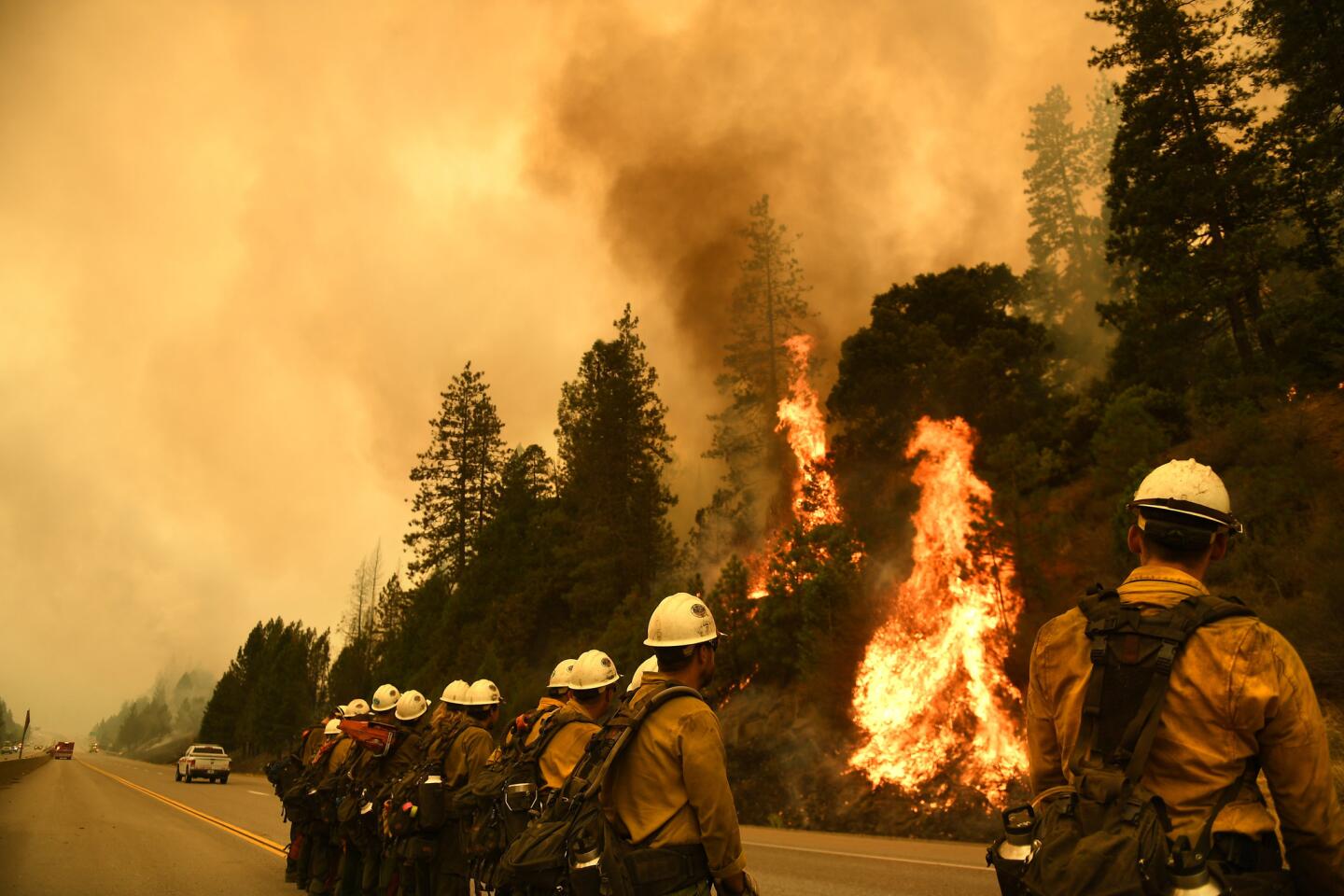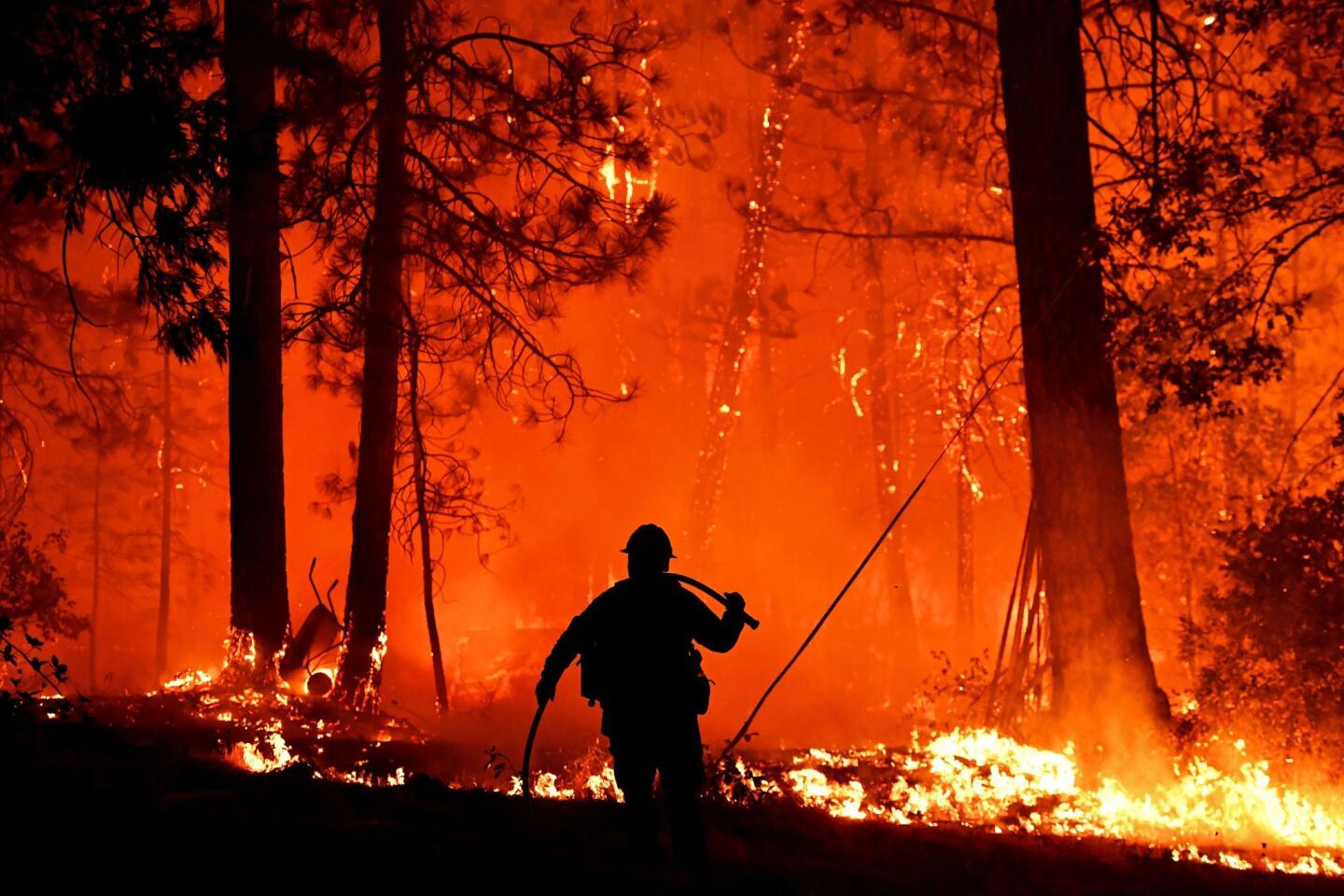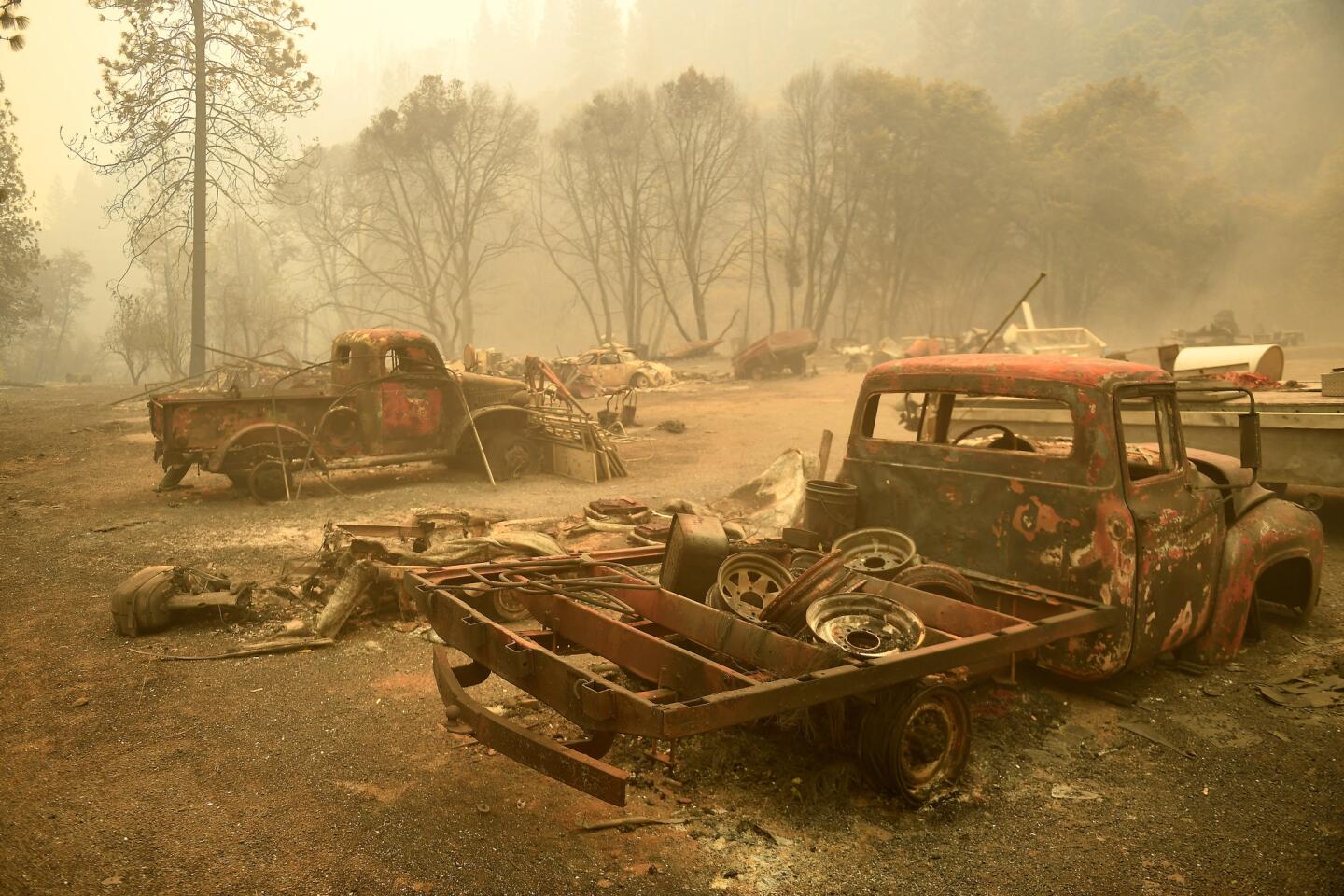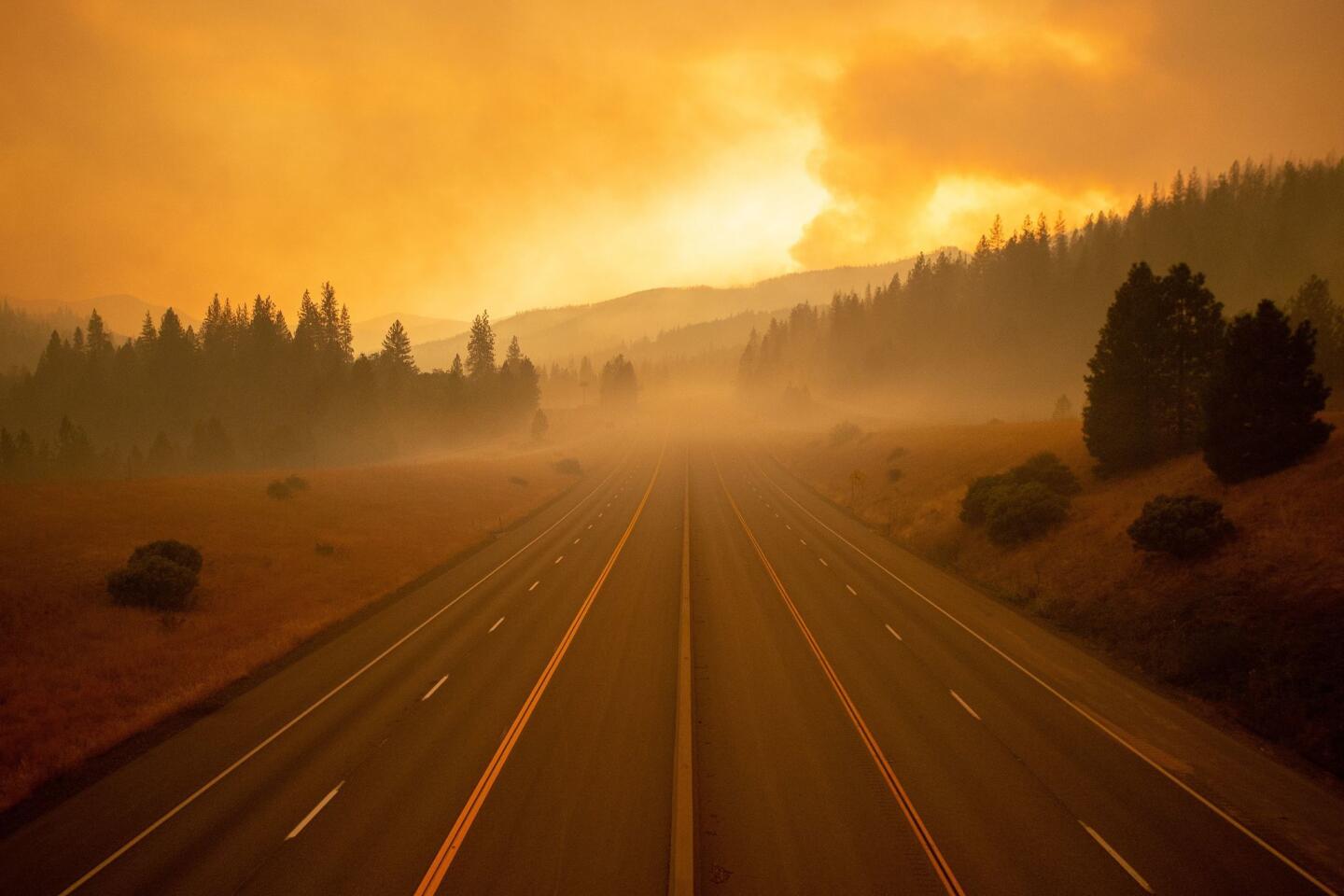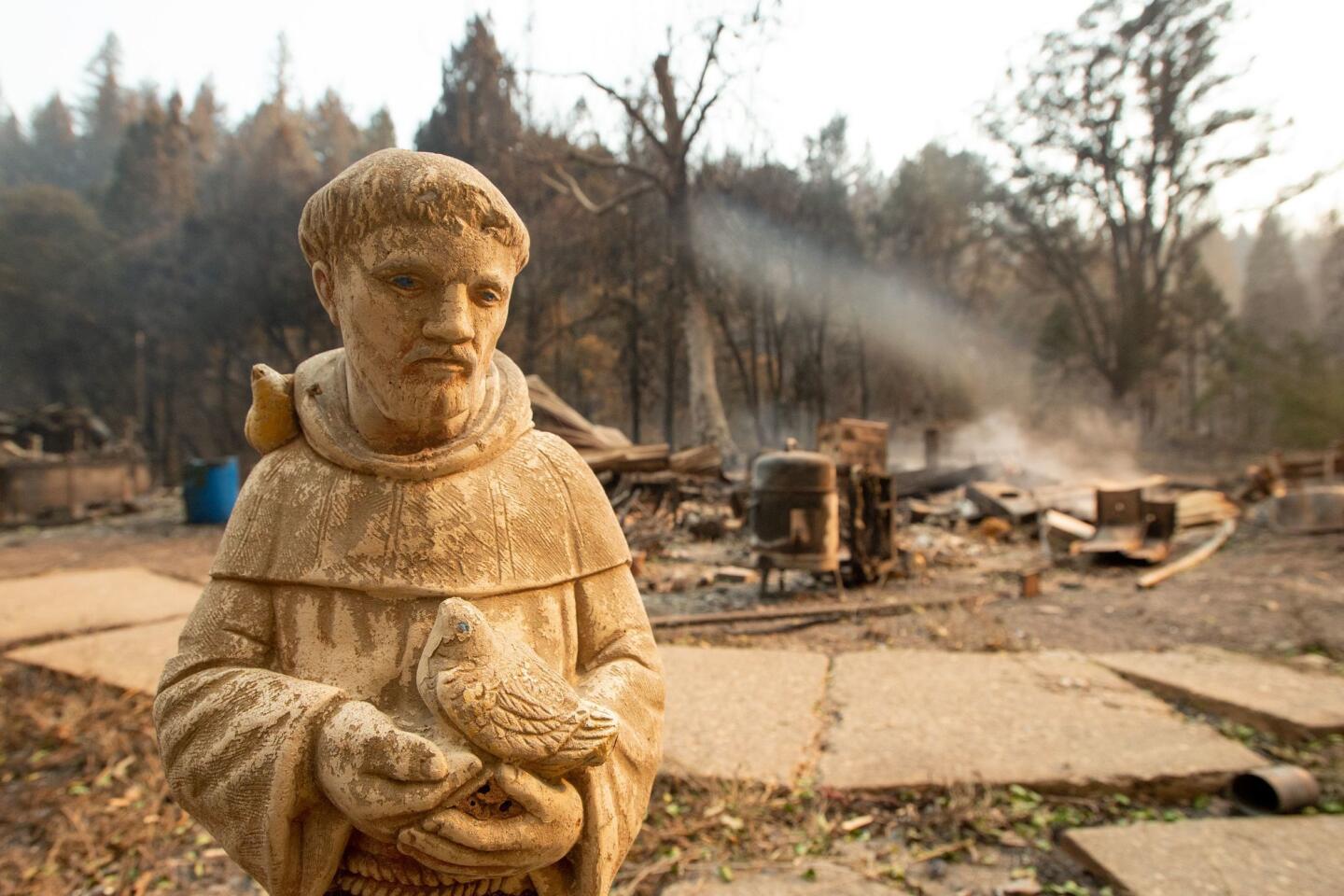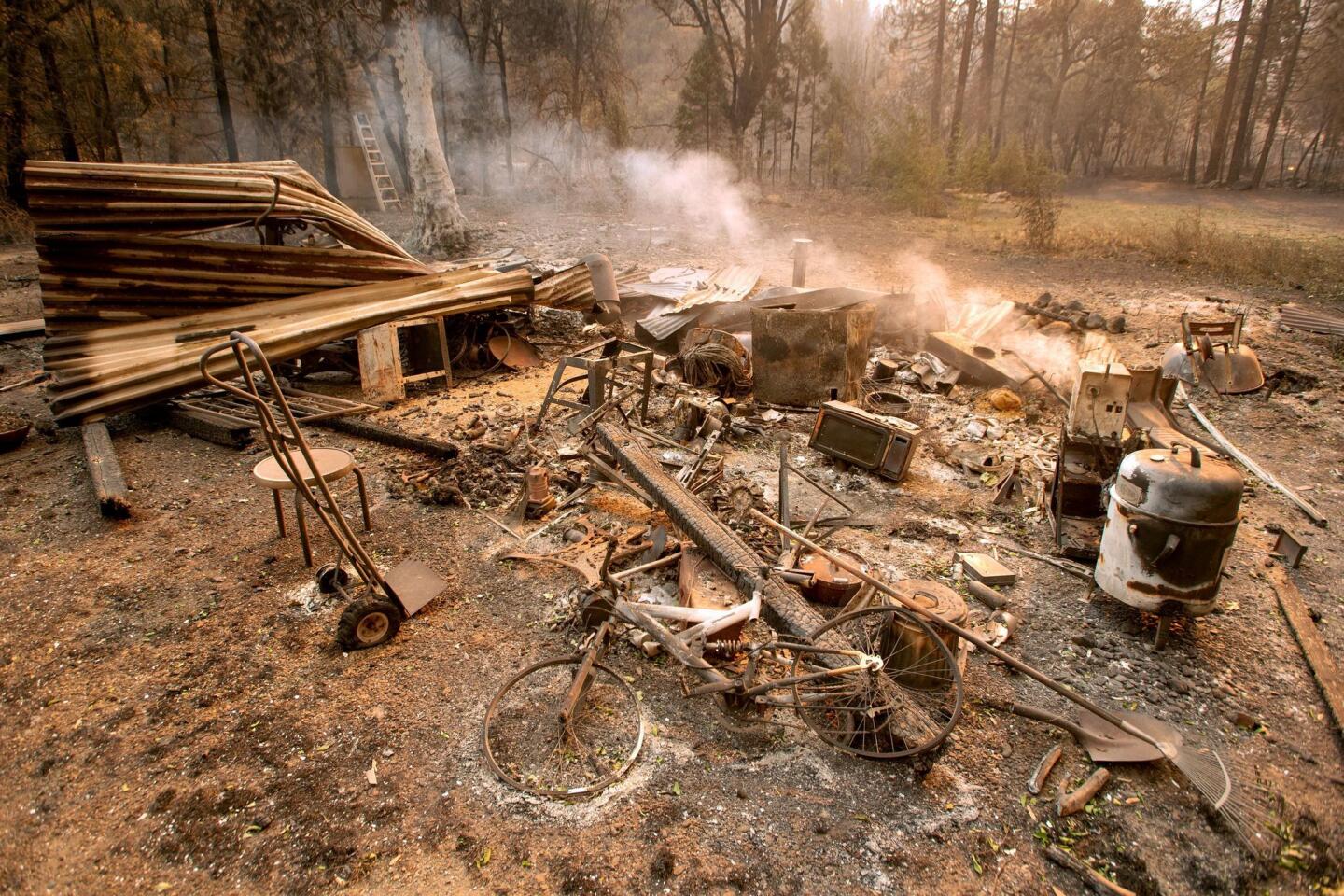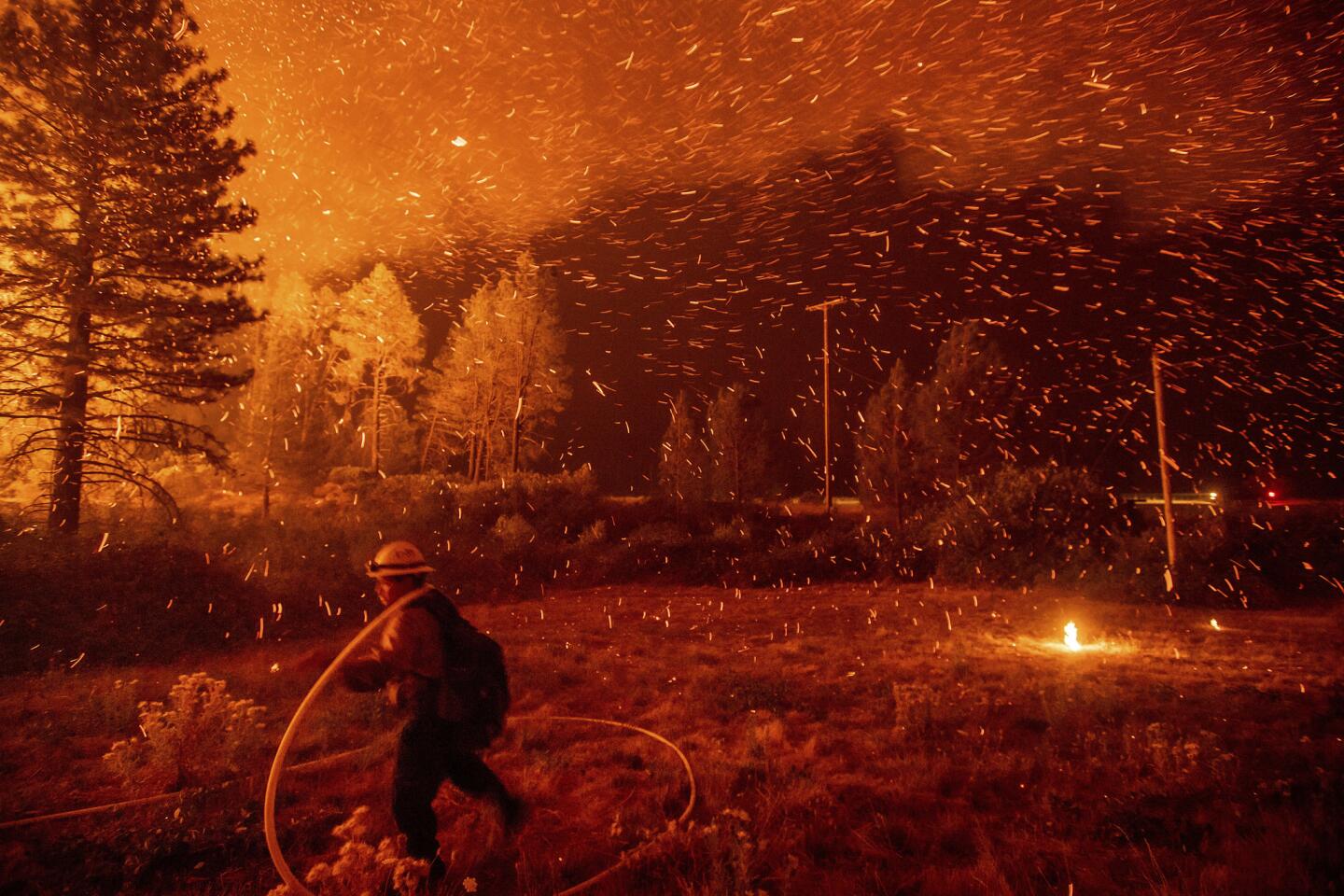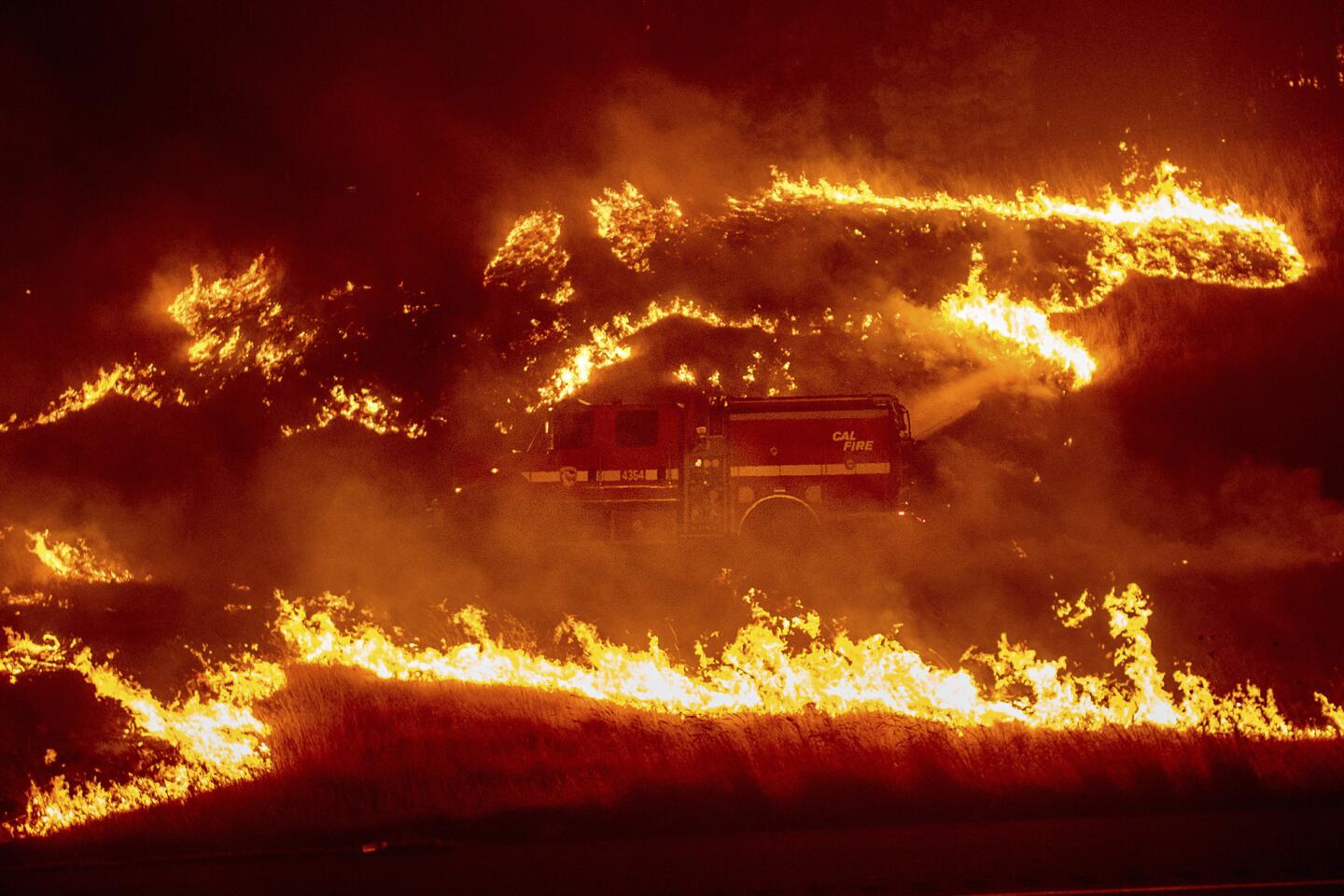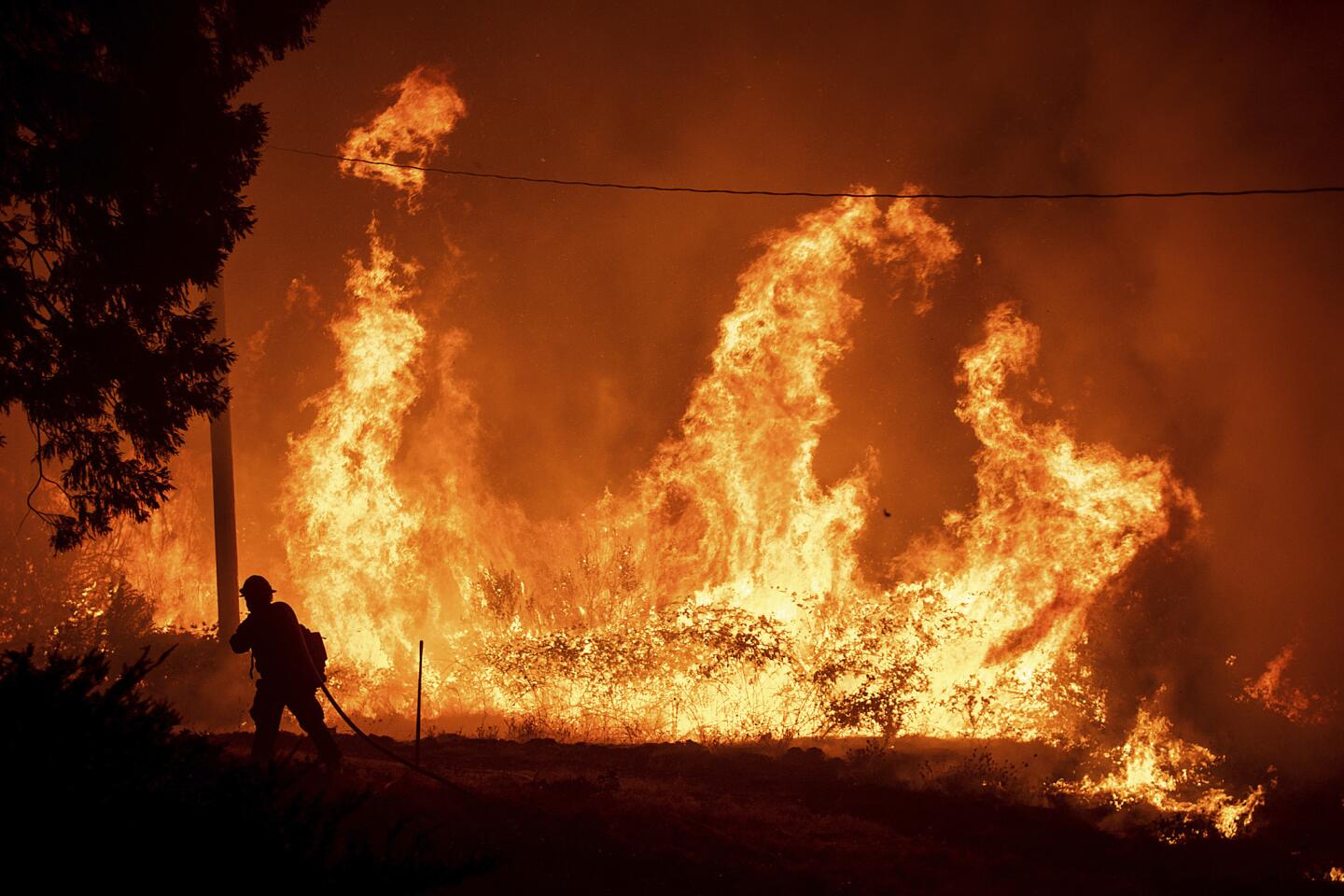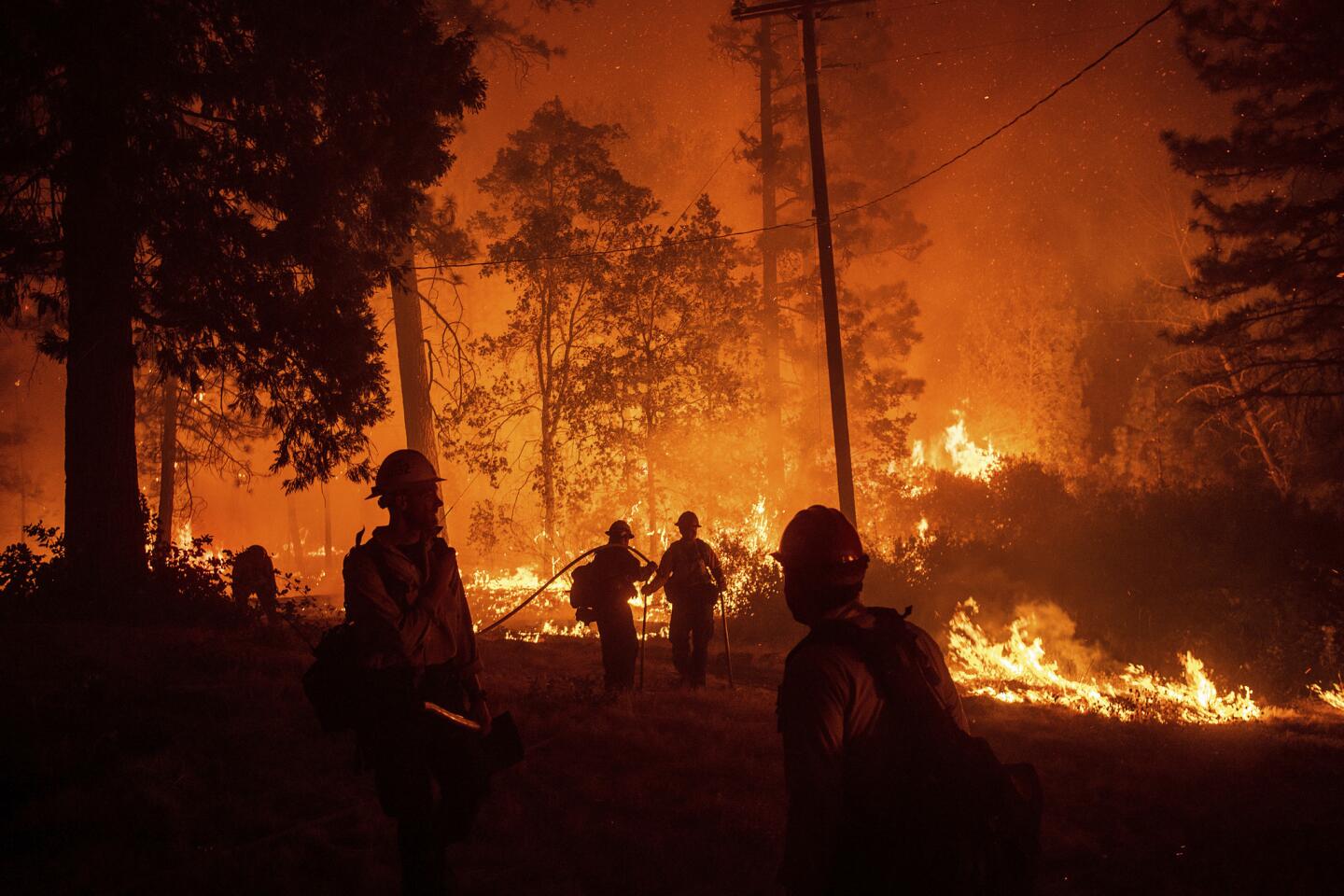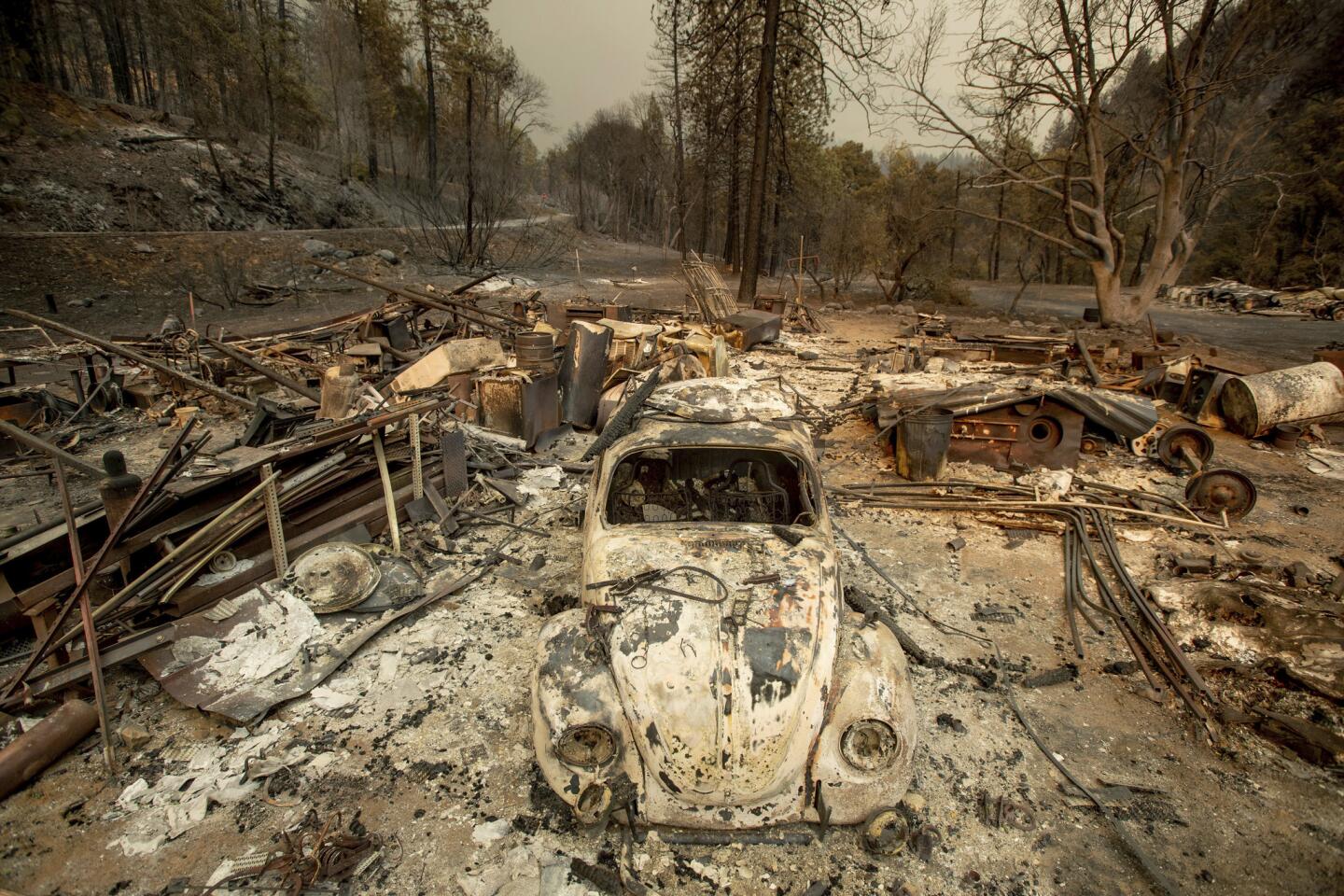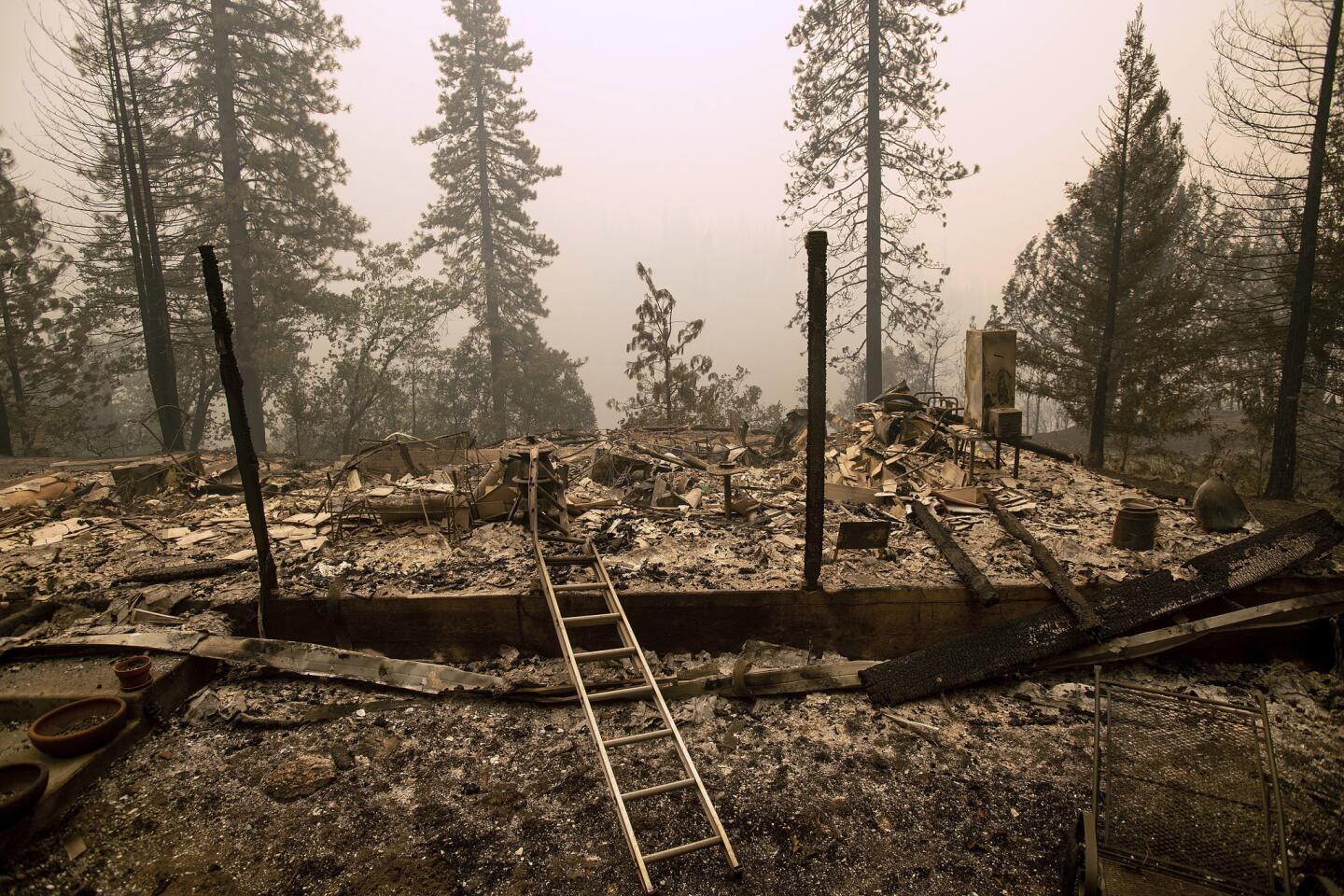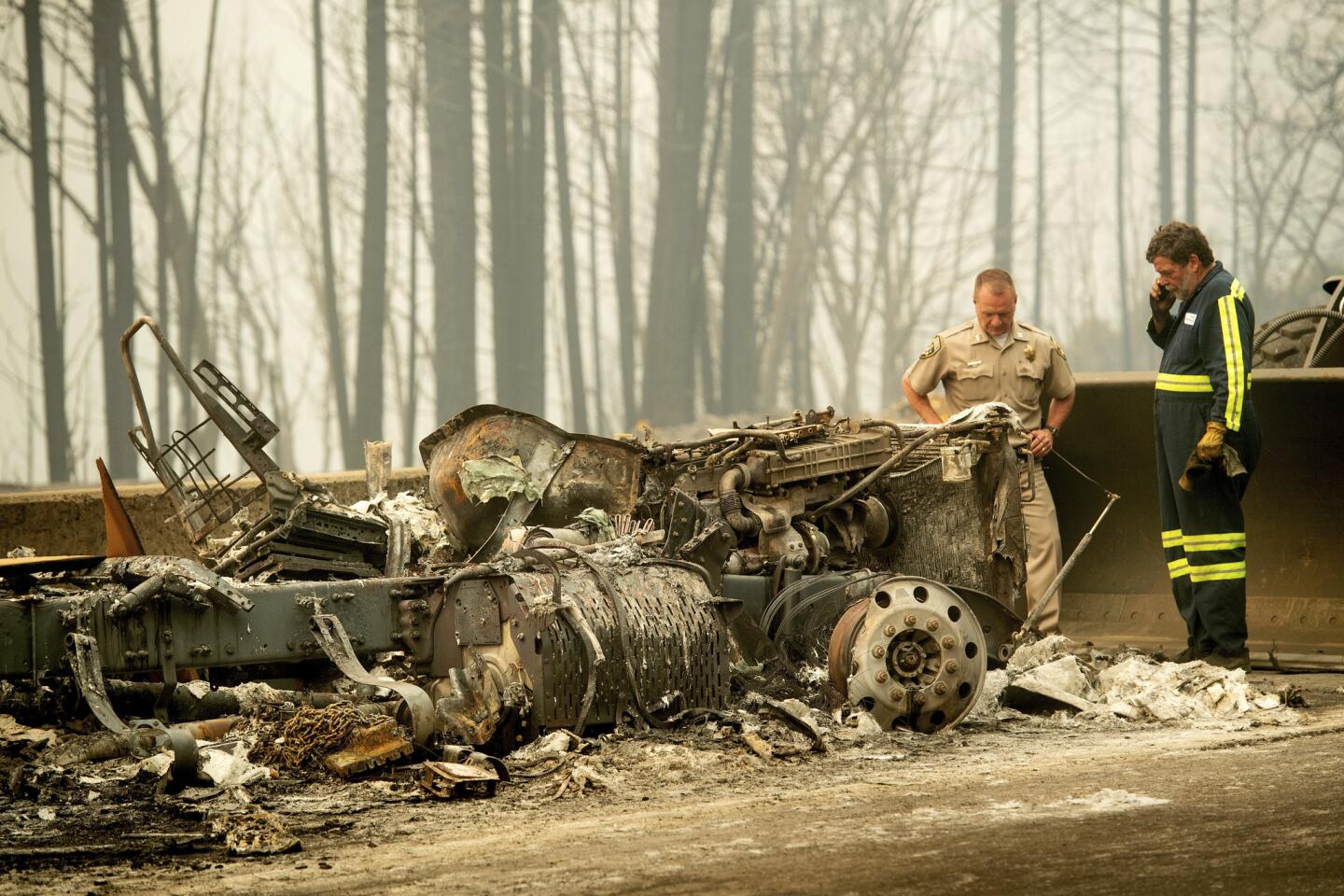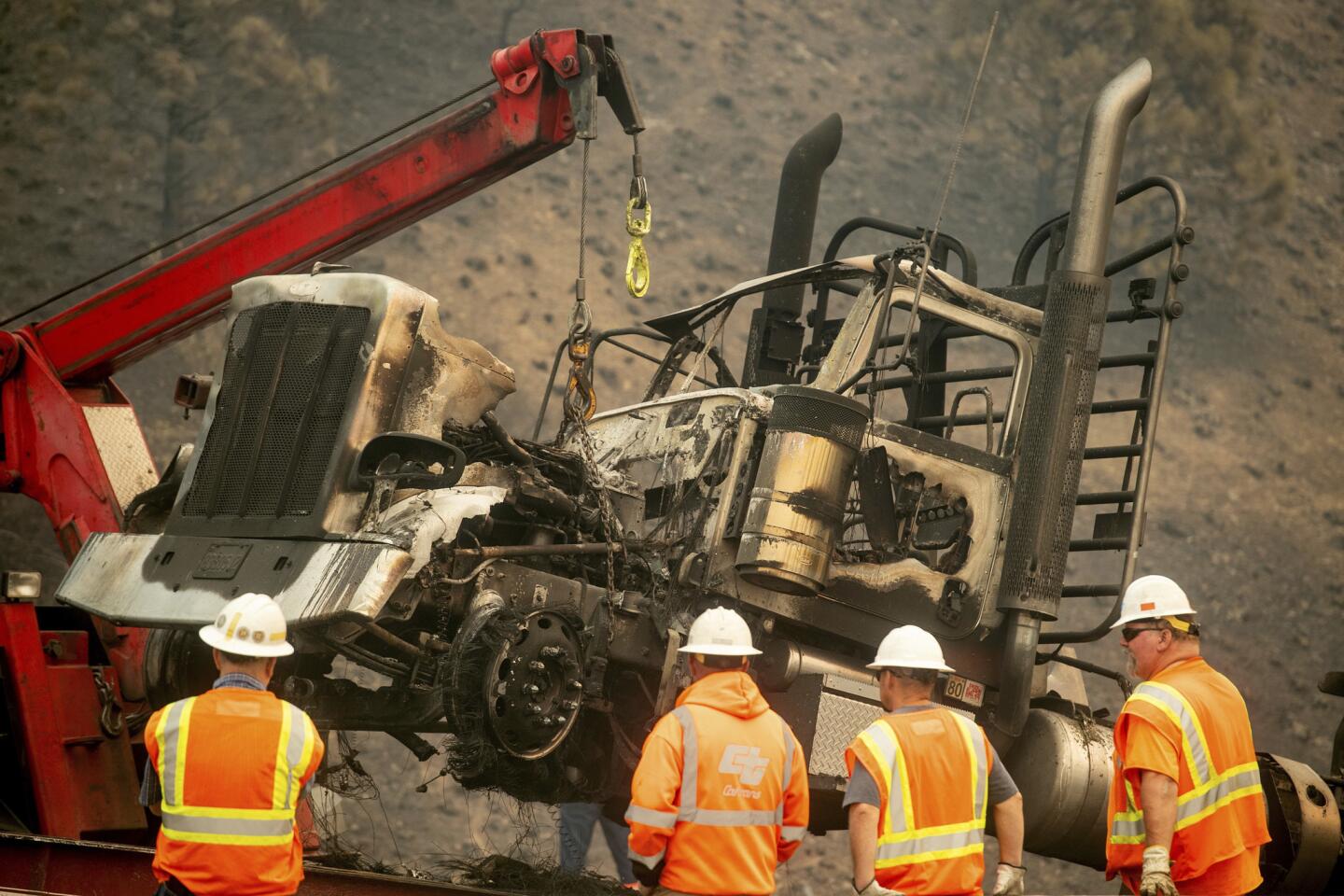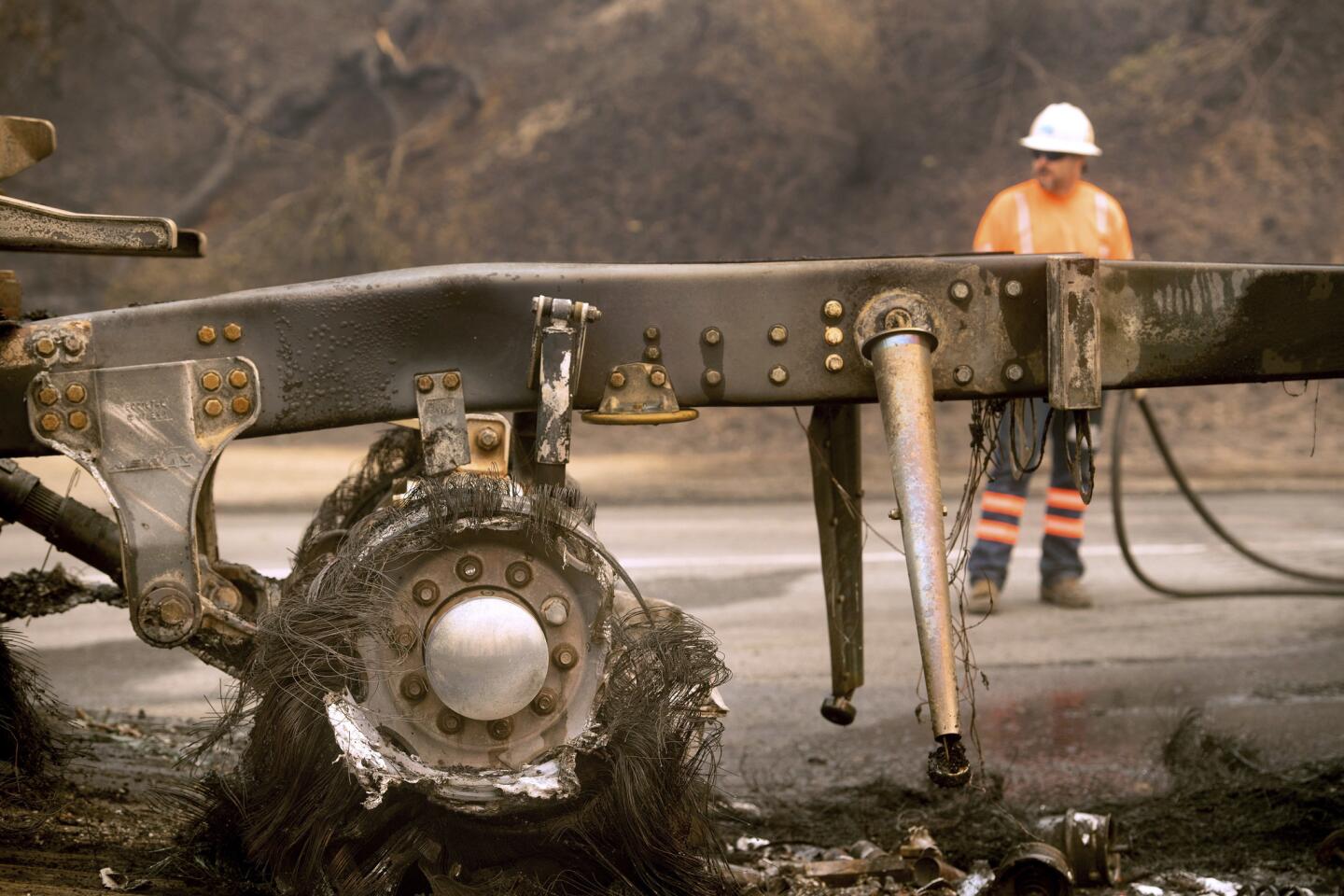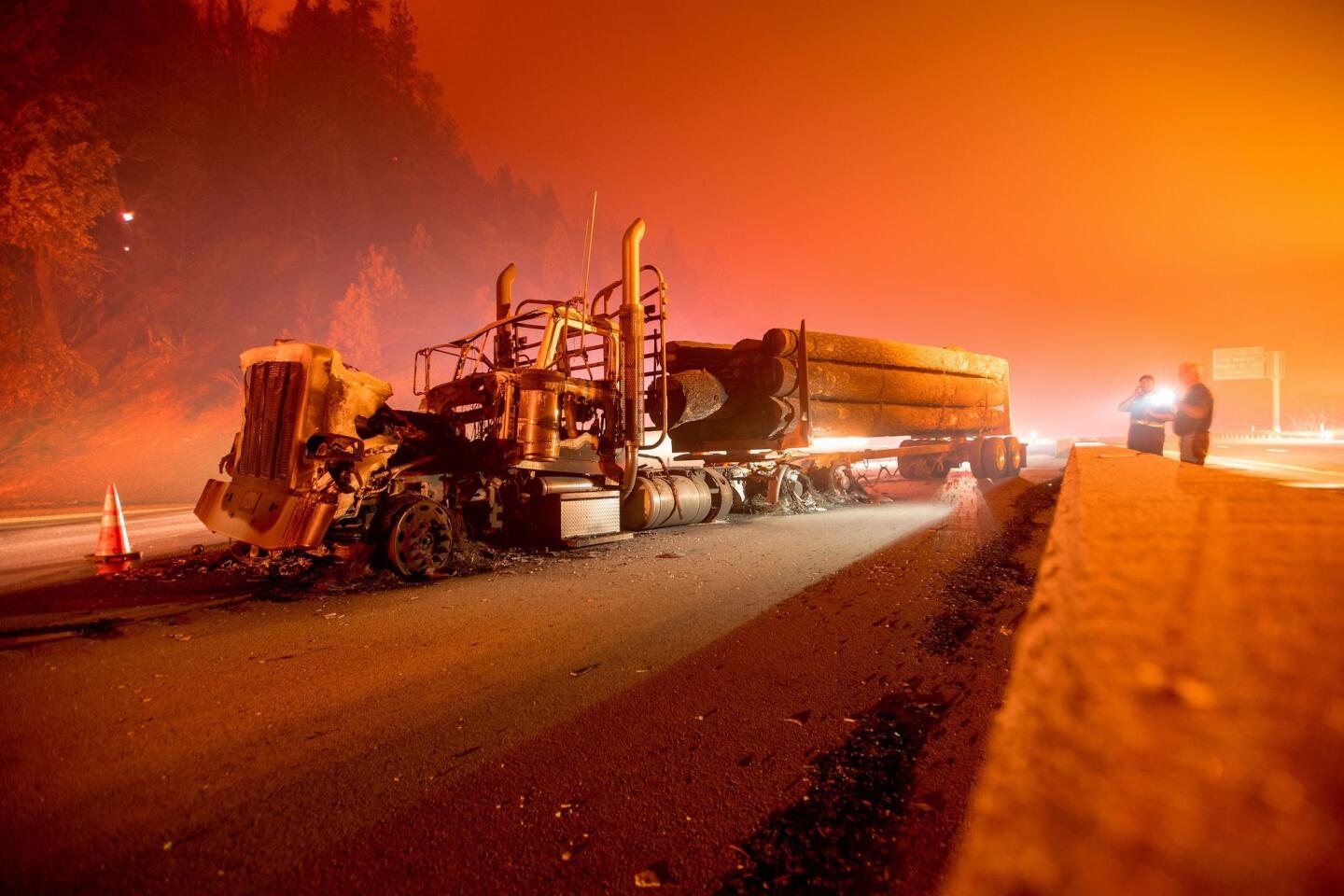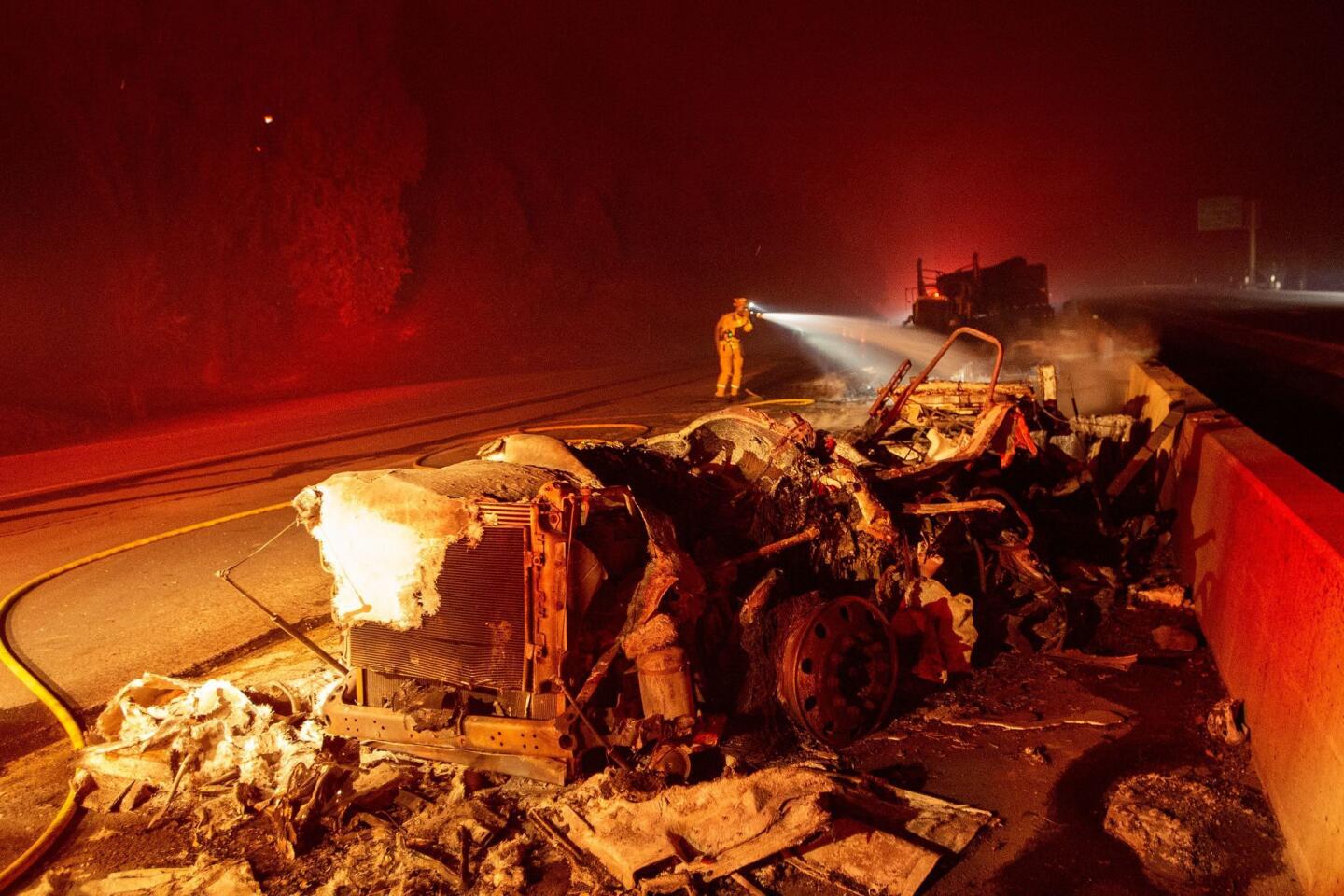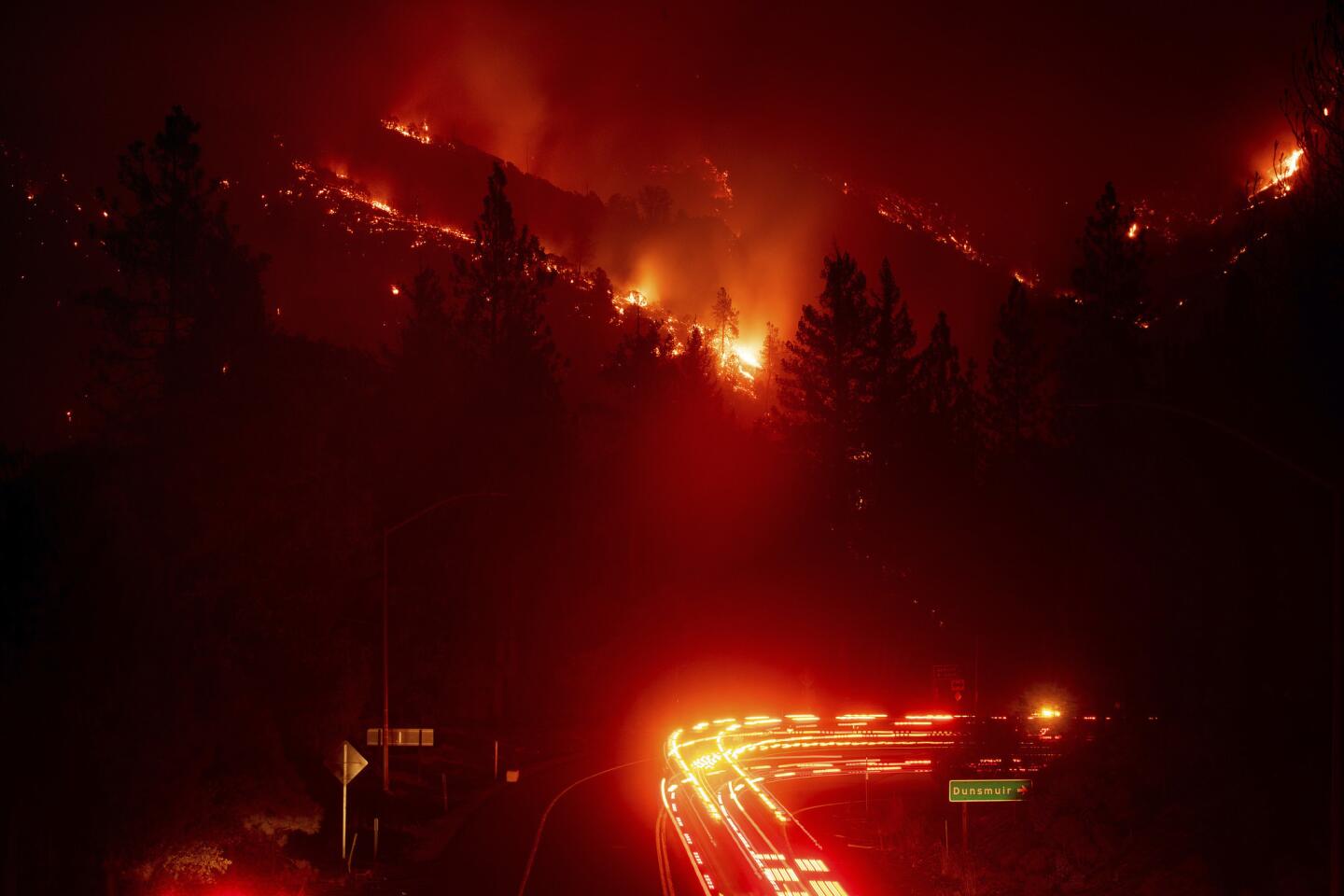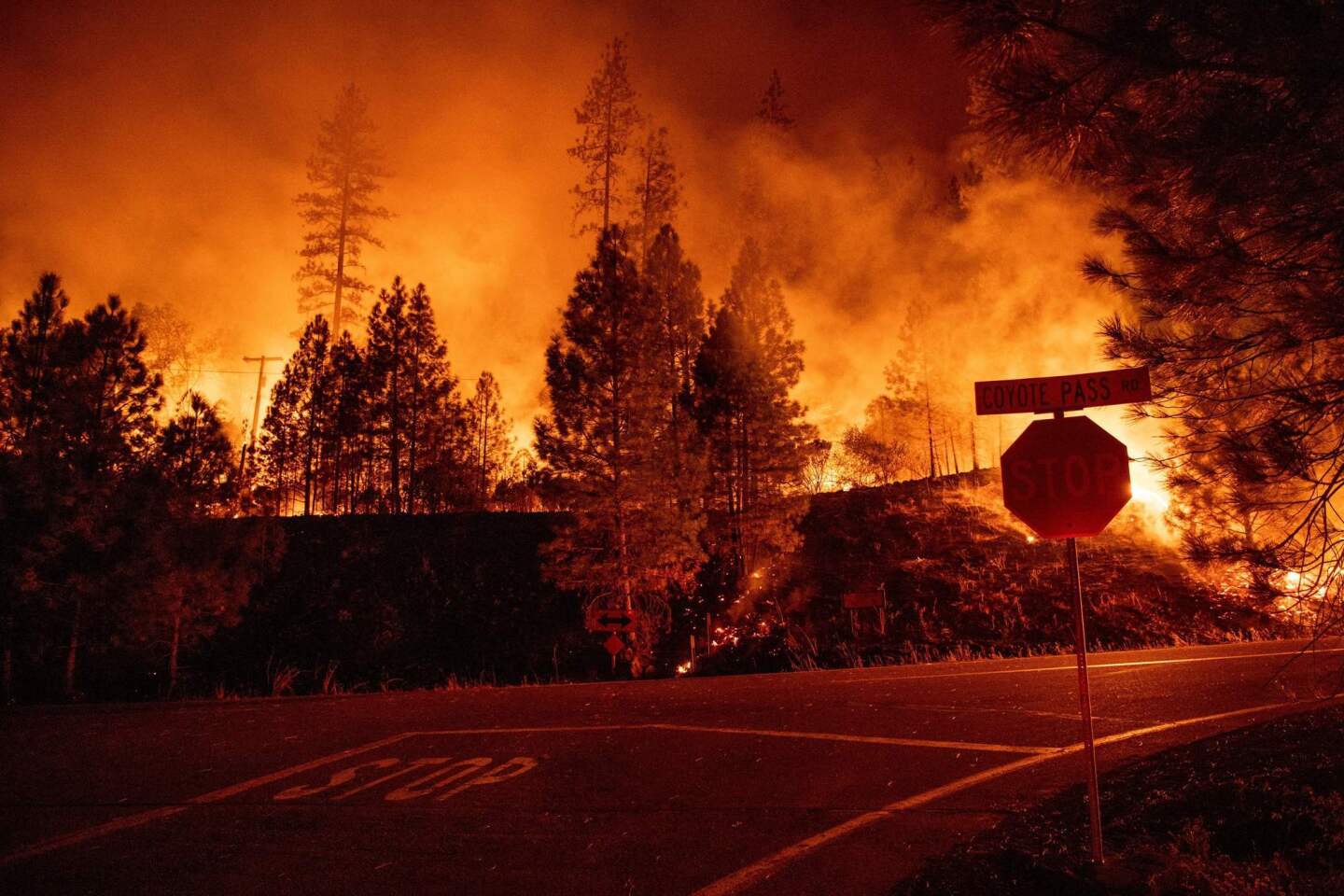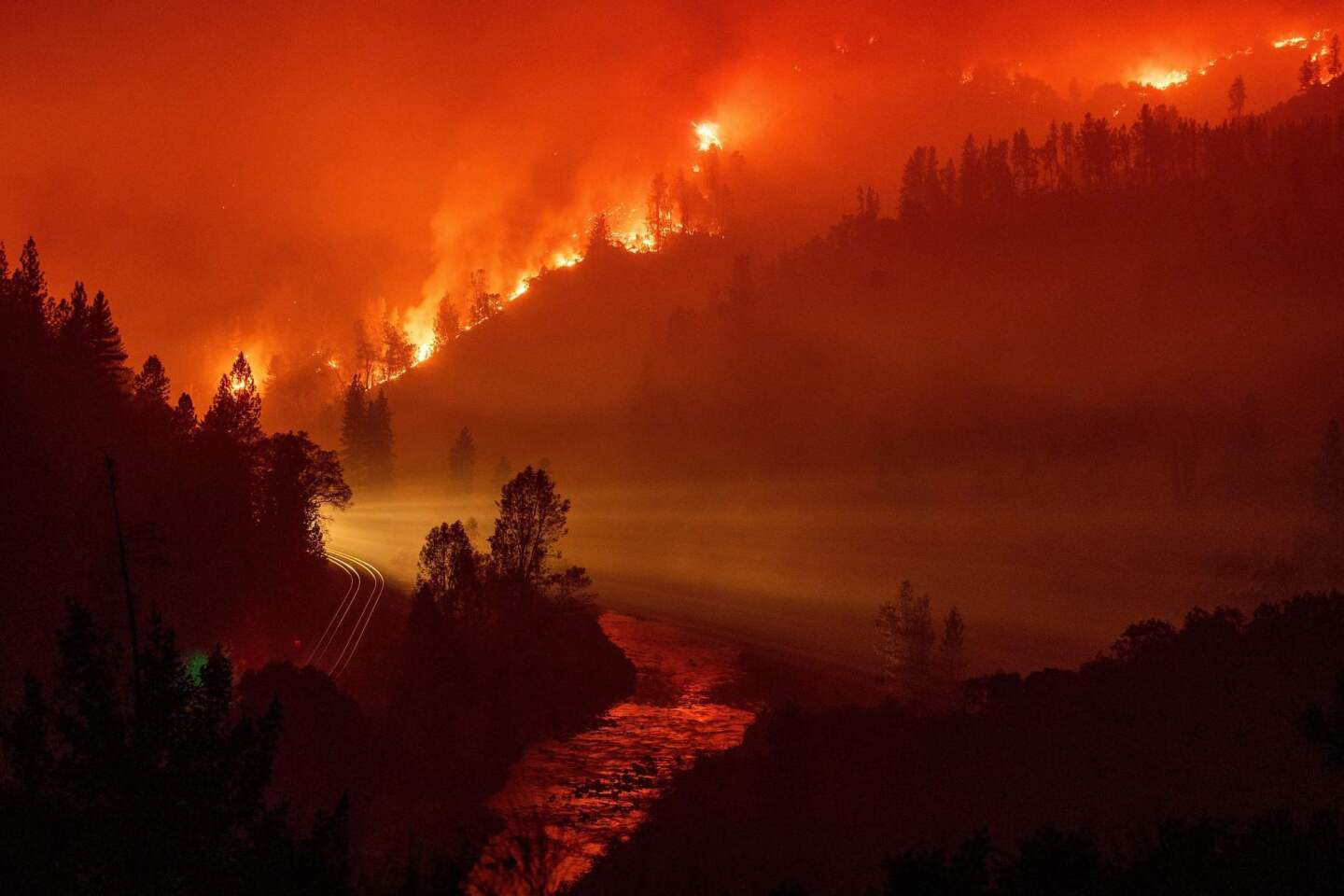Delta fire scorches 22,000 acres in Shasta County, forces evacuation and shutters main highway
- Share via
Stan Kulak was waiting outside his home for his brother to finish packing when he spotted 200-foot flames burning through pine trees along Interstate 5.
Those in the line of the fire, like Kulak, knew they needed to leave quickly.
The 71-year-old had been napping minutes earlier when his brother, Skip, alerted him that a wildfire was rapidly approaching their homes. For more than 20 years, the family has lived on 40 acres behind the Pollard Flat restaurant and gas station, about 36 miles north of Redding.
Kulak rushed to pack his laptop, two family heirlooms — an old wooden clock that had belonged to his grandmother and a .22-caliber rifle — and most importantly, his Jack Russell terrier, Ducky.
Helicopters hovered above while a dozen fire engines surrounded Kulak’s home, his brother’s home and one other house on the property. Firefighters soaked Kulak’s three-bedroom house in water and cleared brush around the land, but they still couldn’t keep the fast-moving Delta fire from consuming the structure.
“They lost a lot of history there,” Kulak’s son Doug Kulak, 35, said. “They didn’t have pictures backed up on computer and up to the cloud like I would, so when they lost everything, they lost everything.”
By Thursday evening, a day after the blaze broke out in the Shasta-Trinity National Forest, the Delta fire had chewed through 22,000 acres of timber and dense brush. Three homes had been damaged and 150 others were under threat. Roughly 300 people had evacuated along I-5 from Lamoine to the Shasta-Siskiyou county line, according to Capt. Brandon Vaccaro, a fire spokesman.
The wildfire was initially reported as three fires Wednesday afternoon north of Lakehead — a community of about 500 people near the Vollmers exit on I-5 — but it merged into one fire and spread rapidly. At one point, the blaze burned up to one mile per hour.
Vaccaro said there was “human involvement” in igniting the blaze, but it is not clear whether it was an accident or arson.
The fire’s quick growth was fueled partly by warm weather and winds, and officials are not anticipating much relief Thursday. Temperatures are expected to reach the mid-90s in areas where the fire is burning, and winds with gusts in the 15- to 20-mph range are expected through the afternoon.
Firefighters faced challenges managing the flames overnight as extremely dry brush in the region and low humidity worked against them. Usually, thanks to cooler temperatures and humidity, wildfires slow their progress overnight. With embers flying, about 1,400 fire personnel battling both the Delta fire and nearby Hirz fire had to deal with spot fires popping up throughout the area. Massive trees that had ignited to create 300-foot flames greeted fire crews on the front lines.
Officials said an inversion layer that will trap smoke is expected to lift by midday Thursday, which could mean the fire will start burning more aggressively. At the Ferguson fire near Yosemite National Park earlier this year, firefighters saw a slow-burning wildfire transition to a much more dynamic blaze once the inversion layer that sat over the area for two weeks fully lifted.
When an inversion layer lifts, one concern is that a wildfire will form a pyrocumulus, or fire cloud, which then can create a weather pattern within the wildfire. This sometimes causes dry lightning.
Over the next several hours, fire officials expect the Delta fire to spread farther north toward Gibson, east toward Greens Mountain and west toward Damnation Peak. By early Friday, the fire could expand east toward the area recently burned by the Hirz fire, a 46,150-acre blaze that’s 80% contained, according to fire officials.
The blaze also forced the closure of I-5 — a main artery between Redding and the Oregon border — from Fawndale Road to about four miles south of the city of Mount Shasta at Mott Road.
Motorists who were stuck on I-5 at the onset of the blaze watched from their vehicles as flames devoured trees and advanced toward the highway. One woman pulled out her phone to document the fire in a video that later was posted to social media as traffic remained at a standstill.
“Oh, my God. I want to go,” the woman, identified on Instagram as Narraf Ellesse, screamed. “We’ve got to get out and walk. We cannot stay right here.”
She began to sob as the flames jumped along the treetops. Some truckers unlatched their trailers in an effort to escape the blaze. Others opted to catch a ride with strangers and abandon their vehicles completely.
“It was a flee-for-your-life situation,” said Vaccaro, the fire captain.
About 17 tractor-trailer trucks were left on the interstate, and at least four were destroyed by the fire. The blaze also damaged guardrails, culverts and other portions of the freeway, officials said.
“I can’t even imagine what these people were dealing with,” Vaccaro said. “The heat is so extreme with these wildfires that you can feel it driving by. It’s very scary.”
When the fire started, law enforcement officers were diverting hundreds of cars and trucks to the Lamoine exit to turn around, but the fire started advancing rapidly toward that once-safe location, said Lt. Cmdr. Kyle Foster of the California Highway Patrol’s Mount Shasta office. Officers had to send cars and trucks through a 12-foot gap in the center median designed for emergency vehicles. Remarkably, they were able to get all vehicles turned around and away from the fire, he said.
“The positive side of this, Northern California has been very stricken by fires recently, and while it’s catastrophic and heartbreaking, most of the citizens and agencies are well-versed in these types of situations,” Foster said. “The community acts very appropriately when we ask them to leave.”
Union Pacific Railway also shut down its route in the area after its tracks were damaged in the blaze.
The company has water cars protecting its tracks and other equipment in areas where it’s safe enough to travel within, Union Pacific spokesman Justin Jacobs said.
Between eight and 15 trains move through the stretch daily hauling a range of goods — including batteries, televisions and cars — and make up roughly the equivalent of about 3,000 semi trucks a day, Jacobs said.
“It’s a pretty significant amount of cargo,” he said.
Times staff writer Alene Tchekmedyian contributed to this report.
Twitter: @Hannahnfry
UPDATES:
7:45 p.m.: This article was updated with new fire figures.
12:35 p.m.: This article was updated with additional information from fire officials, comments from residents and Union Pacific Railway.
This article was originally published at 8:40 a.m.
More to Read
Sign up for Essential California
The most important California stories and recommendations in your inbox every morning.
You may occasionally receive promotional content from the Los Angeles Times.
